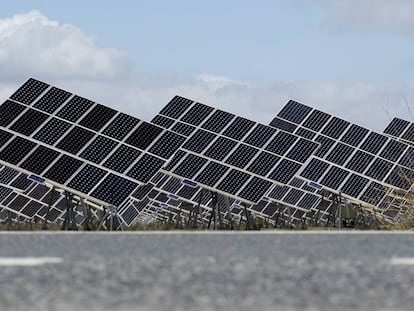How penguins toppled two Chilean government ministers
Division over a mining project located near a unique marine nature reserve in Chile has taken its first political casualties

“I have eaten penguin before, marinated!” the fisherman Salvador Vergara yells over the boat’s noisy motor. “It is exquisite with spring onions,” he adds. The 49-year-old sails around the Chilean island of Choros in the heart of the Humboldt National Penguin Reserve – the last penguin stronghold on the planet. Back in 1990 when the reserve was created, these small black-striped penguins were commonly eaten in stews or marinated – a practice that put them on the brink of extinction. But today, penguin numbers have bounced back to 16,000. Indeed the penguins hold so much sway that they have achieved the unthinkable: the resignation of two government ministers.
Vergara lives in Punta de Choros, a peaceful fishing community on the northern coast of Chile. It is a unique spot. The three islands that make up the Humboldt National Penguin Reserve are nourished by the Humboldt Current, the underwater highway that brings nutrients from Antarctica to Ecuador. This rich, low-lying current rises to the surface, providing a banquet for various ocean species.

The reserve is home to bottlenose dolphins, marine otters and sea lions. The majestic blue whale, weighing 180 tons, even passes through the waters, along with fin whales and humpbacks. But this paradise is under threat. Vergara warns: “We live off fishing and tourism. If Dominga comes, we will be sitting with our arms crossed.”
Dominga is a project of the Chilean company Andes Iron to create an enormous open pit mine, capable of producing 12 million tons of iron concentrate and 150,000 tons of copper concentrate a year to meet growing demand in China. The project also includes a new port with a 1.2-kilometer pier.
The $2.5-billion iron mine would provide jobs for 1,500 people for 27 years
The plan has outraged Punta de Choros with signs saying “defend the ocean from the murderous Dominga project” and “No to Dominga: Punta de Choros isn’t for sale” plastered across the fishing village. But inland, just a few kilometers from the coast, the message is very different. Signs hanging from bridges on the Panamerican highway argue: “The ecosystem and the mine can coexist, yes to Dominga;” and: “No to malnutrition, yes to Dominga.”
The town of Higuera – where the penguin reserve is located – is divided. The coastal population, which depends on fishing and the 80,000 tourists who visit each year, say the mine will destroy their livelihoods. The people who live inland, on the other hand, are poorer and see the project as a much-needed lifeline.
In La Higuera, 22% of its 4,600 residents live in poverty – almost double the rate in the rest of the country. The $2.5-billion iron mine would provide jobs for 1,500 people for 27 years.
But Pablo Arrósipde, the administrator of the Humboldt National Penguin Reserve, warns the project could be environmentally devastating.

“Obviously, there could be a spill of hydrocarbons or oil, exotic, invasive species could be introduced accidentally, and this would affect penguins nesting and the lives of the marine mammals,” he explains. “The reserve is a very important economic engine for the region, given that tourism has increased exponentially in recent years.”
Óscar Avilez, the spokesperson for the Punta Norte Fishing Cooperative, says that members of his association are being bullied into supporting the mining project.
”The Dominga mine has become a constant threat with harassment and pressure against our members,” he explains, as he walks along a beach covered in abalone snails. “Some are offered benefits like motors and boats. It has practically divided our community – divided us so they could rule over us.”
There could be a spill of hydrocarbons or oil, and invasive species could be accidentally introduced
Pablo Arrósipde, administrator of the Humboldt National Penguin Reserve
According to Avilez, his organization, with 150 members, exports a million units of Chilean abalone a year, mostly to Asian markets.
Perched on a blue boat, Josué Ramos, the president of the Los Choros Cooperative, says he also opposes Dominga. “As fisherman we are against the Dominga mining project because they want to build a mega port. And in Chile, the history of mega ports for mines is filled with national catastrophes,” he explains, flanked by his two daughters and a puppy.
Armando Siña, a geologist and the vice-president of Andes Iron, smiles as he listens to the criticism of his project. “First and foremost, we will be 30 kilometers away from the Humboldt National Penguin Reserve. It’s a considerable distance,” he says from the barren landscape where the mine would be located. The company has organized an advertisement campaign with the slogan: “The best mining project in the world.”

According to Siña, only 56 boats a year would arrive at the Dominga mega port and they would not carry or offload any fuel. “Ten kilometers from the coast there already is another shipping route used by 1,600 boats a year,” he adds.
The Humboldt National Penguin Reserve has become the epicenter of a global war between those who want economic growth and those who want to protect the environment. In August, 2017, the battle caused its first casualties. After a series of contradictory verdicts from different environmental authorities, the Dominga mine project reached Chile’s Ministers Committee. It was rejected by government of then-President Michelle Bachelet but Finance Minister Rodrigo Valdés and Economy Minister Luis Felipe Céspedes resigned in protest.
The Dominga mine has become a constant threat with harassment and pressure
Fisherman Óscar Avilez
“Some do not have growth among their top priorities and this sometimes makes it difficult for them to juggle this with other objectives that are also important,” stated Valdés.
“All this has all caused a huge stir in Chile, because the project was seen to be rejected more for political reasons than for technical or environmental ones,” explains Siña.
The marine conservation organization Oceana revealed links between the mining project and the family of conservative politician Sebastian Piñera – Bachelet’s former rival, and, as of March 11, 2017, Chile’s new president.
Andes Iron recognized itself that the Piñera family had “passively participated” in the early stages of the project in 2010 through an investment fund. Today, 75% of the company belongs to the family of the Chilean businessman Carlos Alberto Délano, a lifelong friend of Piñera.

The future of the mine and the Humboldt National Reserve now depends on the courts, say pessimists. In April, the Antofagasta Environmental Court overturned the decision to reject the project, citing irregularities in the procedure. But on May 16, lawyers for Oceana and other environmental and fishing organizations appealed to the Supreme Court to reject the Dominga mine.
Magaly Báez, a young member of the Higuera community, sums up the desperation of those in favor of the mine. “My father is a fisherman and I am in favor of the Dominga project, because we need development in the area. The government has abandoned us for 40 years. We see an opportunity for development and for jobs for people, ourselves and our children.”
English version by Andres Cayuela.

